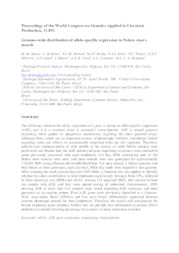Genome-wide distribution of allele-specific expression in Nelore steers muscle.
Genome-wide distribution of allele-specific expression in Nelore steers muscle.
Resumo: Summary. The difference between the allelic expression of a gene is known as allele-specific expression (ASE), and it is a common event in mammal?s transcriptome. ASE is named genomic imprinting when guided by epigenetics mechanisms regarding the allele parental origin. Although these events are an important sources of phenotypic variation, knowledge thereof regarding cattle and effects on economically important traits are still incipient. Therefore, analysis and characterization of ASE profile in the muscle of adult Nelore animals were performed, and besides that, the ASE pattern and gene imprinting occurrence were checked in genes previously associated with meat tenderness. For this, RNA sequencing data of 146 Nelore steer muscles were used, and these animals were also genotyped for approximately 770,000 SNPs using Illumina BovineHD BeadChip. For each animal, a diploid genome was built based on their genotypes, and afterward, RNA-Seq reads were mapped to this genome. After counting the reads considering each SNP allele, a binomial test was applied to identify whether the allele contribution to total expression significantly diverged from 50%, followed by false discovery rate (FDR) test (0.05). Among 519 analyzed SNPs, 402 showed at least one sample with ASE, and they were spread among all autosomal chromosomes. SNPs showing ASE in more than five samples were tested regarding ASE extension, and most presented an incomplete pattern. Four ASE genes were previously identified in a Genome-Wide Association Study (GWAS) and five were found differentially expressed between extreme phenotype animals for meat tenderness. Therefore, the results will complement the bovine imprinted genes database, further they can provide new information to genetic effects prediction in animal breeding increasing the accuracy of meat tenderness selection.
Ano de publicação: 2018
Tipo de publicação: Anais e Proceedings de eventos (considerados no todo)
Unidade: Embrapa Agricultura Digital
Observações
1 - Por padrão são exibidas publicações dos últimos 20 anos. Para encontrar publicações mais antigas, configure o filtro ano de publicação, colocando o ano a partir do qual você deseja encontrar publicações. O filtro está na coluna da esquerda na busca acima.
2 - Para ler algumas publicações da Embrapa (apenas as que estão em formato ePub), é necessário ter, no celular ou computador, um desses softwares gratuitos. Sistemas Android: Google Play Livros; IOS: iBooks; Windows e Linux: software Calibre.
Acesse outras publicações
Acesse a Base de Dados da Pesquisa Agropecuária (BDPA) para consultar o acervo completo das bibliotecas da Embrapa.

